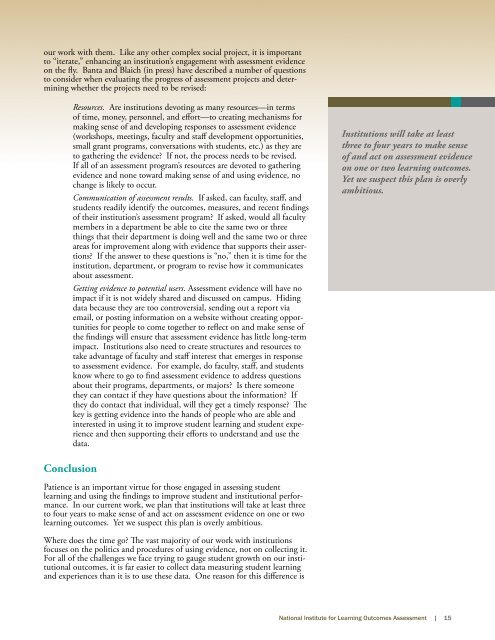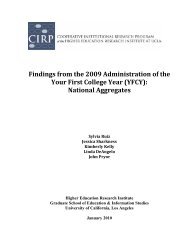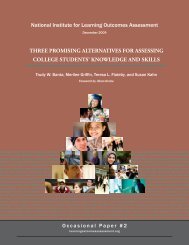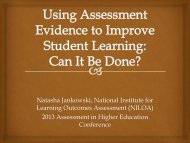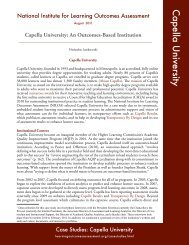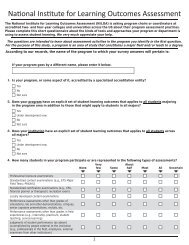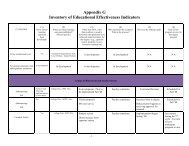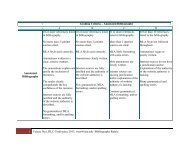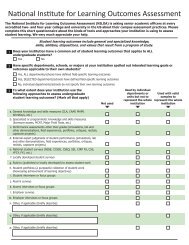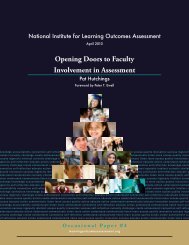From Gathering to Using Assessment Results: - National Institute for ...
From Gathering to Using Assessment Results: - National Institute for ...
From Gathering to Using Assessment Results: - National Institute for ...
You also want an ePaper? Increase the reach of your titles
YUMPU automatically turns print PDFs into web optimized ePapers that Google loves.
our work with them. Like any other complex social project, it is important<strong>to</strong> “iterate,” enhancing an institution’s engagement with assessment evidenceon the fly. Banta and Blaich (in press) have described a number of questions<strong>to</strong> consider when evaluating the progress of assessment projects and determiningwhether the projects need <strong>to</strong> be revised:Resources. Are institutions devoting as many resources—in termsof time, money, personnel, and ef<strong>for</strong>t—<strong>to</strong> creating mechanisms <strong>for</strong>making sense of and developing responses <strong>to</strong> assessment evidence(workshops, meetings, faculty and staff development opportunities,small grant programs, conversations with students, etc.) as they are<strong>to</strong> gathering the evidence? If not, the process needs <strong>to</strong> be revised.If all of an assessment program’s resources are devoted <strong>to</strong> gatheringevidence and none <strong>to</strong>ward making sense of and using evidence, nochange is likely <strong>to</strong> occur.Communication of assessment results. If asked, can faculty, staff, andstudents readily identify the outcomes, measures, and recent findingsof their institution’s assessment program? If asked, would all facultymembers in a department be able <strong>to</strong> cite the same two or threethings that their department is doing well and the same two or threeareas <strong>for</strong> improvement along with evidence that supports their assertions?If the answer <strong>to</strong> these questions is “no,” then it is time <strong>for</strong> theinstitution, department, or program <strong>to</strong> revise how it communicatesabout assessment.Getting evidence <strong>to</strong> potential users. <strong>Assessment</strong> evidence will have noimpact if it is not widely shared and discussed on campus. Hidingdata because they are <strong>to</strong>o controversial, sending out a report viaemail, or posting in<strong>for</strong>mation on a website without creating opportunities<strong>for</strong> people <strong>to</strong> come <strong>to</strong>gether <strong>to</strong> reflect on and make sense ofthe findings will ensure that assessment evidence has little long-termimpact. Institutions also need <strong>to</strong> create structures and resources <strong>to</strong>take advantage of faculty and staff interest that emerges in response<strong>to</strong> assessment evidence. For example, do faculty, staff, and studentsknow where <strong>to</strong> go <strong>to</strong> find assessment evidence <strong>to</strong> address questionsabout their programs, departments, or majors? Is there someonethey can contact if they have questions about the in<strong>for</strong>mation? Ifthey do contact that individual, will they get a timely response? Thekey is getting evidence in<strong>to</strong> the hands of people who are able andinterested in using it <strong>to</strong> improve student learning and student experienceand then supporting their ef<strong>for</strong>ts <strong>to</strong> understand and use thedata.Institutions will take at leastthree <strong>to</strong> four years <strong>to</strong> make senseof and act on assessment evidenceon one or two learning outcomes.Yet we suspect this plan is overlyambitious.ConclusionPatience is an important virtue <strong>for</strong> those engaged in assessing studentlearning and using the findings <strong>to</strong> improve student and institutional per<strong>for</strong>mance.In our current work, we plan that institutions will take at least three<strong>to</strong> four years <strong>to</strong> make sense of and act on assessment evidence on one or twolearning outcomes. Yet we suspect this plan is overly ambitious.Where does the time go? The vast majority of our work with institutionsfocuses on the politics and procedures of using evidence, not on collecting it.For all of the challenges we face trying <strong>to</strong> gauge student growth on our institutionaloutcomes, it is far easier <strong>to</strong> collect data measuring student learningand experiences than it is <strong>to</strong> use these data. One reason <strong>for</strong> this difference is


